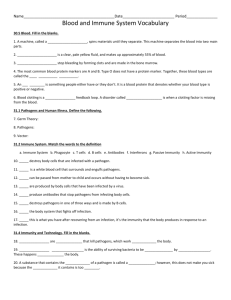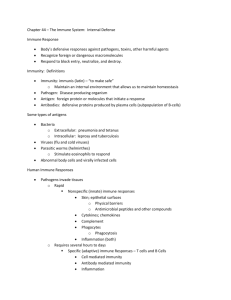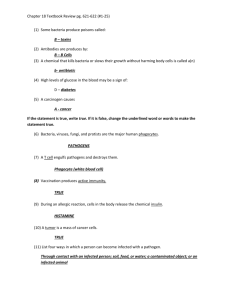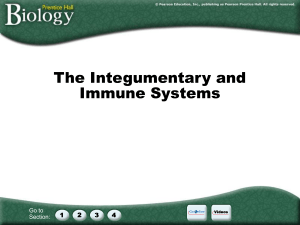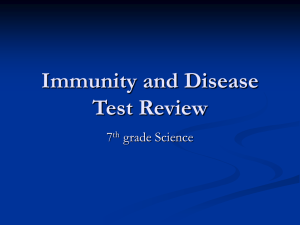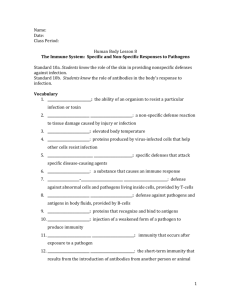The Immune System day Day 2
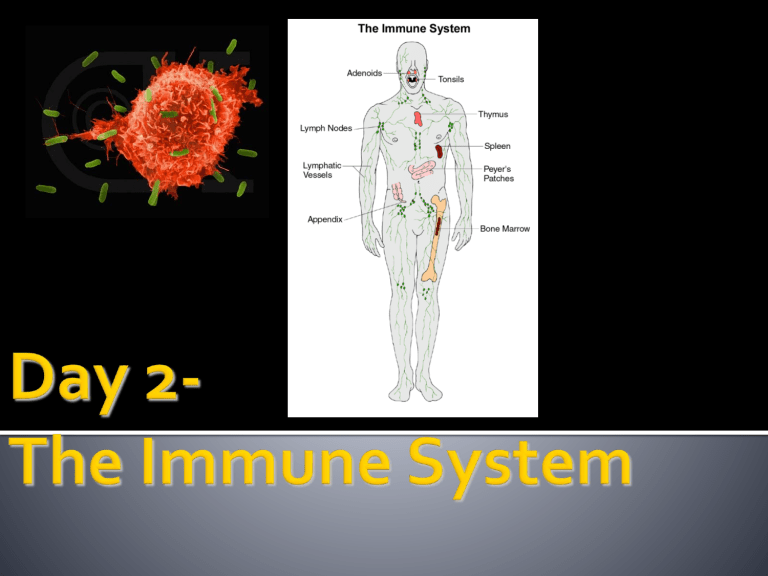
Benchmark(s)
SC.912.L.14.52 Explain the basic functions of the human immune system, including specific and nonspecific immune response, vaccines, and antibiotics. (AA)
SC.912.L.14.6 Explain the significance of genetic factors, environmental factors, and pathogenic agents to health from the perspectives of both individual and public health.
HE.912.C.1.4 Analyze how heredity and family history can impact personal health.
HE.912.C.1.8 Analyze strategies for prevention, detection, and treatment of communicable and chronic diseases.
Students will…
Identify and/or explain the basic functions of the human immune system, including specific and nonspecific immune responses.
Describe how the human immune system responds to vaccines and/or antibiotics.
Explain the significance of genetic factors, environmental factors, and pathogenic agents to health from the perspective of both individual and public health.
Your body has several lines of defense against disease. Explain your body’s mechanisms for keeping you healthy.
(include nonspecific and specific response)
Smallpox was once found throughout the world.
Caused illness and death wherever it occurred.
Smallpox spreads easily from one person to another.
People were once vaccinated against this disease.
The United States stopped giving the smallpox vaccine in 1972.
In 1980, the World Health Organization (WHO) recommended that all countries stop vaccinating for smallpox.
The vaccine is no longer given to the general public because the virus has been wiped out. Or has it?
In ordinary type smallpox the bumps are filled with a thick, opaque fluid and often have a depression or dimple in the center.
More than 200 years ago, the English physician Edward
Jenner wondered if it might be possible to produce immunity against smallpox.
Jenner knew that people who had been affected by a mild disease called cowpox developed an immunity to smallpox.
Jenner took fluid from one of the sores of a cowpox patient and put the fluid into a small cut that he made on the arm of a young farm boy named Jamie Phillips.
Two months later, he injected Jamie with fluid from a smallpox infection and …
The rest is history.
The injection of a weakened form of a pathogen to produce immunity is known as vaccination .
Today, more than 20 serious human diseases can be prevented by vaccination.
Modern vaccines stimulate the immune system to create millions of plasma cells ready to produce a specific types of antibodies.
The type of immunity produced by the body’s reaction to a vaccine is known as active immunity .
May develop as a result of natural exposure to an antigen or from deliberate exposure to the antigen.
If antibodies produced by other animals against a pathogen are injected into the bloodstream, the antibodies produced a passive immunity against the pathogen.
Passive immunity lasts only a short time because eventually the body destroys the foreign antibodies.
Natural passive immunity occurs when antibodies produced by the mother are passed to the offspring during development or in early infancy through breast milk.
Deliberate passive immunity occurs when travelers to certain regions of the world are given vaccines before leaving home.
Because prevention is not always possible, drugs have been developed for the use against some types of pathogens.
Antibiotics are compounds that kill bacteria without harming the cells of the human or animal host and work by interfering with the cellular processes of microorganisms.
Antibiotics have no effect on viruses.
Is a bacterium responsible for several difficultto-treat infections in humans.
MRSA is any strain that has evolved resistance to antibiotics , which include the penicillins
(methicillin, dicloxacillin, ampicillin, oxacillin, etc.)
Resistance does make MRSA infection more difficult to treat thus more dangerous.
MRSA is especially troublesome in hospitals and nursing homes, where patients with open wounds, invasive devices, and weakened immune systems are at greater risk of infection than the general public.
A ruptured MRSA abscess
Mueller Hinton agar showing MRSA resistant to oxacillin disk
Infectious Situation
Bacteria and pathogen on skin surface
Body’s Line of Defense
Skin cells with no gaps or cuts keep out pathogens. Sweat acids kill bacteria.
Pathogens shed with old skin.
Pathogens in nose, mouth, or eyes
Pathogens in digestive tract
Pathogens in burn or cut
Influenza virus enters body for second time
Chickenpox virus enters body for second time
Measles virus enters body soon after measles vaccine
Rabies pathogens enter body from rabid dog bite
Your body has several lines of defense against disease. Explain your body’s mechanisms for keeping you healthy.
(include nonspecific and specific response)
Which of the following statements best describes the relationships among possible environmental influences, the p53 gene, and cancer?
A. Environmental influences can lead to mutations in the p53 gene, which can cause certain cancers.
B. Increased levels of p53 protein, rather than environmental influences, can cause certain cancers.
C. Mutations in the p53 gene increase environmental influences that can cause certain cancers.
D. Genes such as p53 are less causal than environmental influences in stimulating certain cancers.


